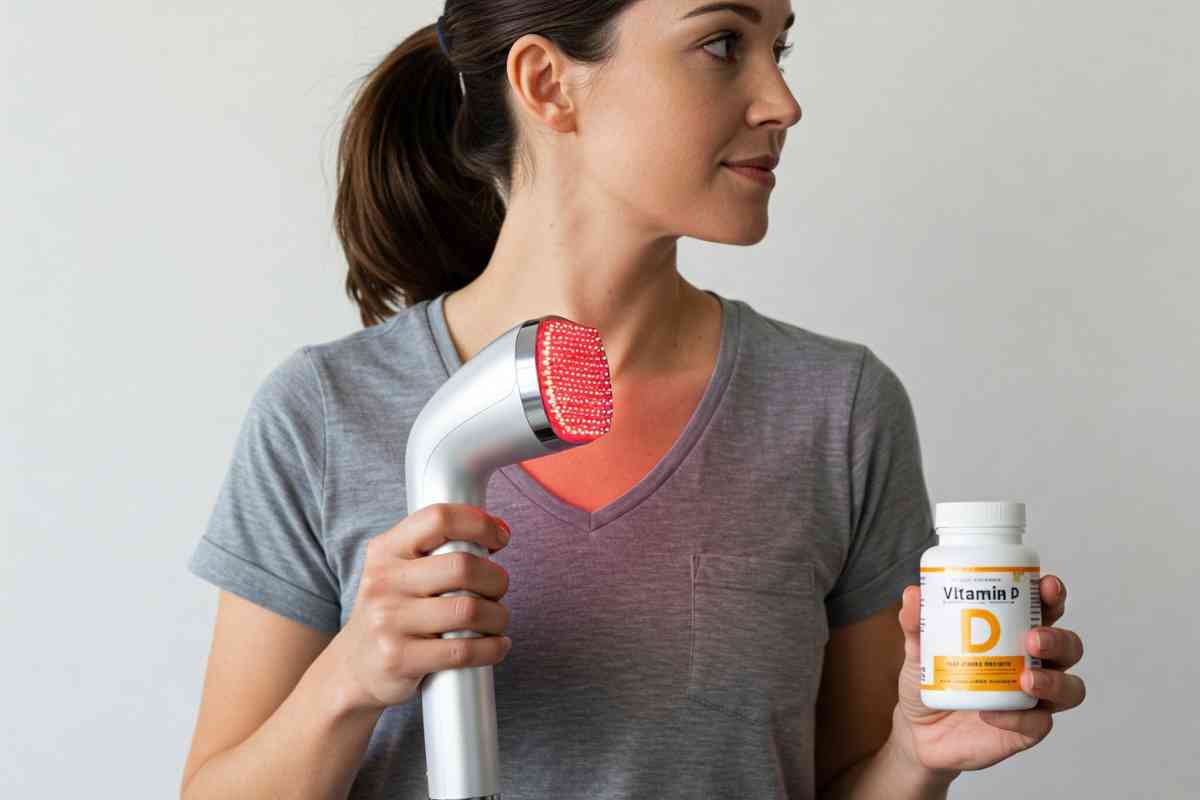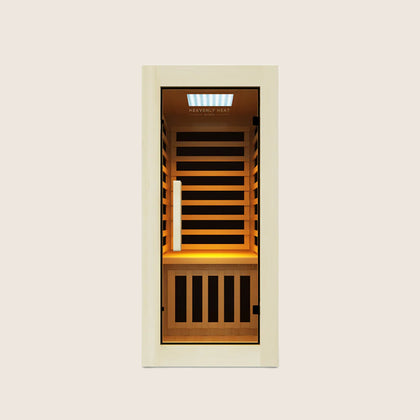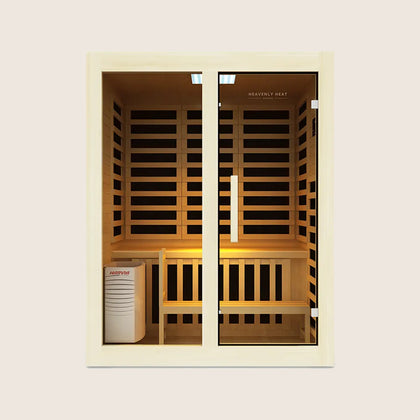Does Red Light Therapy Increase Vitamin d?

Struggling with fatigue, bone pain, and mood swings? These are common symptoms of vitamin D deficiency, and they can seriously affect your daily life.
Ignoring it could lead to more severe issues like muscle weakness or increased risk of illness.
But what if red light therapy could help boost your vitamin D levels? Read on to find out!
Table of contents
Key Takeaways
-
Red light therapy does not directly stimulate vitamin D production like UVB light.
-
While red light therapy can support skin health and immune function, it doesn't replace the need for sunlight or UVB exposure for vitamin D synthesis.
-
People with limited sun exposure may benefit from red light therapy in maintaining overall health, but should still rely on sunlight or supplements for vitamin D.
-
Red light therapy complements vitamin D supplements by promoting healing and reducing inflammation, but does not directly enhance vitamin D absorption.
-
Combining red light therapy with vitamin D supplements may offer additional health benefits, especially for those with limited sunlight exposure.

What Is Vitamin D ?
Medical News Today explains that vitamin D is not just a vitamin, it acts more like a hormone essential for bone strength, immune support, and inflammation regulation. The body produces it naturally when exposed to sunlight, but various factors can interfere with this process, leading to deficiency.
The most common causes of vitamin D deficiency include:
Limited sun exposure : Indoor lifestyles, high pollution, or living in northern regions reduces sun-driven vitamin D synthesis.
Darker skin tones : Increased melanin decreases UVB absorption needed to produce vitamin D.
Aging : Older adults produce less vitamin D in the skin and often spend more time indoors.
Obesity : Excess fat can trap vitamin D, making it less available for use.
Certain medical conditions : Diseases affecting fat absorption (like celiac or Crohn’s) limit vitamin D uptake.
Exclusive breastfeeding : Breast milk alone doesn’t supply enough vitamin D for infants.
Low levels may cause fatigue, muscle weakness, or in severe cases, bone pain and developmental problems in children. This can affect energy, immunity, and overall well-being.
Thankfully, managing deficiency is straightforward. A daily walk in the sun, eating fortified foods, or taking doctor-recommended supplements can restore healthy levels. With awareness and small lifestyle tweaks, maintaining vitamin D becomes a simple, empowering part of self-care.
Does Red Light Therapy Stimulate Vitamin D Synthesis Like UVB Light?
- UVB light helps your body make vitamin D naturally: UVB rays from the sun start a process in your skin that creates vitamin D3, which your body needs for strong bones and overall health.
- Midday sunlight gives your skin the most vitamin D: The best time to get UVB rays is between 10 a.m. and 3 p.m., when the sun is highest and your body can make vitamin D faster.
- Too much UVB can hurt your skin if you’re not careful: Spending too long in strong sun can damage your skin and raise your risk of skin cancer, so it’s important to not overdo it.
- Red light helps your skin stay healthy but doesn’t make vitamin D: Red light therapy can improve skin health and reduce inflammation, but it doesn’t help your body produce any vitamin D on its own.
- Red light can prepare your skin to make more vitamin D later: Even though red light doesn’t make vitamin D directly, it can make your skin thicker and healthier, which helps when you do get UVB exposure.
- Only UVB light directly makes vitamin D in your body: If your goal is to boost vitamin D through light, UVB is the only type that works directly. Red light can’t replace that function.
- Vitamin D supplements help, but sunlight does more: Taking vitamin D pills can raise your levels, but sunlight exposure also brings extra health benefits that supplements don’t provide.
Question |
Red Light Therapy | UVB Light | Vitamin D Supplements |
| Does it stimulate vitamin D production? | No |
Yes |
No |
| Supports skin health? | Yes |
Yes |
Yes |
| Helps reduce inflammation? | Yes |
No |
No |
| Affects immune function? | Yes |
Yes |
Yes |
Other Therapies that help with Vitamin d
Sunlight Exposure (UVB Therapy)
Sunlight, especially UVB rays, helps your body make vitamin D naturally. When UVB light hits your skin, it turns a chemical in your skin into cholecalciferol, which your body uses to create vitamin D.
The more skin you expose, the more vitamin D your body can make. A 2015 study in the Journal of Photochemistry and Photobiology B: Biology showed this clearly.
People who exposed just their face and hands still saw a boost in vitamin D, but exposing larger areas like the upper body or whole body increased it even more.
Ultraviolet (UVB) Phototherapy
Your skin makes vitamin D when sunlight hits it, specifically the UVB rays. These rays turn a natural substance in your skin into vitamin D3, which then travels into your blood and helps your body stay healthy.
This process becomes super important when your body can’t absorb enough vitamin D from food.
One study in Photodermatol Photoimmunol Photomed, 2007 showed that a UVB lamp, similar to natural sunlight, helped people with cystic fibrosis and short bowel syndrome boost their vitamin D levels during winter, proving how powerful UVB light can be for vitamin D support.
Vitamin D-Rich Diet
Eating the right foods can give your body a healthy boost of vitamin D, especially when you’re not getting enough sunlight.
Your body absorbs vitamin D from foods like fish, egg yolks, and liver, these are natural powerhouses for keeping your vitamin D levels up.
But the problem is, most people don’t eat enough of these foods. According to Progress in Biophysics and Molecular Biology (2006), many diets fall short, and experts say we need at least 10 micrograms of vitamin D daily when sunlight is low. Fortified foods and supplements can help fill the gap.
Vitamin D Supplements
Yes, vitamin D supplements really do help boost your vitamin D levels. When you take a supplement, usually vitamin D3, your body absorbs it, then your liver and kidneys turn it into a form your body can actually use.
This helps your bones, immune system, and overall health. For example, a 2024 study in the Journal of Health, Population and Nutrition followed women who took 50,000 IU of vitamin D3 once a month for a year.
Their vitamin D levels went up, especially in those who were low to start with, and their cholesterol levels even improved.
How Does Red Light Therapy Affect Vitamin D Levels in People with Limited Sun Exposure?
- Red Light Therapy and Limited Sun Exposure: Introduce the concept of red light therapy being an option for those who have limited sun exposure due to lifestyle or geographic location.
- How Red Light Therapy Stimulates Vitamin D Production: Explain how red light therapy works through specific wavelengths of light that stimulate processes in the skin and indirectly support vitamin D levels.
- Vitamin D Retention and the Role of Red Light Therapy: Mention how the vitamin D produced by UV light stays in the body longer (2-3 days) compared to dietary sources and how red light therapy indirectly supports overall health during limited sunlight exposure.
- Red Light at Sunrise and Sunset: Skin Pre-conditioning: Discuss how red light at specific wavelengths (600-650nm) is abundant during sunrise and sunset, helping to pre-condition the skin for harsher midday UV rays.
- Protecting the Skin with Red and Near-Infrared Light: Detail the protective benefits of red light therapy, which can reduce sunburn severity when combined with UV exposure and offer added skin protection.
- Health Benefits Beyond Vitamin D: Highlight other health benefits of red light therapy, including improving skin health and supporting immune function, especially during times of limited sunlight.

Can Red Light Therapy Help with Vitamin D Deficiency?
- Red Light Therapy and Vitamin D Production: Introduces the idea that red light therapy can support vitamin D production, but it is not a direct replacement for UVB light.
- Supporting Vitamin D Levels in Winter: Highlights the benefit of red light therapy in winter months when sunlight exposure is limited, making it harder to maintain healthy vitamin D levels.
- An Alternative for Sunlight Deficiency: Discusses red light therapy as an alternative for individuals who struggle to get enough sunlight or have difficulty absorbing vitamin D naturally.
- Safe and Convenient Vitamin D Boost: Emphasizes the safety and convenience of using red light therapy to enhance the body’s ability to produce more vitamin D.

Red Light Therapy vs. Vitamin D Supplements
Mechanism of Action
- Red light helps your cells make more energy: Red light therapy works by activating mitochondria, the powerhouses in your skin cells, so they can make more energy and help your body heal faster.
- More energy in skin cells means better collagen and smoother skin: This extra energy boosts collagen production, which improves skin elasticity and helps reduce wrinkles or sagging over time.
- Vitamin D helps your body take in calcium: Vitamin D’s main job is to help your intestines absorb calcium, which your bones and teeth need to stay strong and healthy.
- Sunlight makes vitamin D, red light doesn’t: Only UVB rays from the sun can start vitamin D production in your skin, red light therapy can’t do this, no matter how strong it is.
- Only part of vitamin D supplements actually gets used: When you take vitamin D pills, only about 60% makes it through your digestive system and into your liver for use by your body.
- Taking vitamin D with fatty food helps your body absorb more: If you eat healthy fats with your vitamin D supplements, your body absorbs the vitamin much better and uses it more effectively.
Health Benefits
- Tissue Repair and Inflammation Reduction: Highlights how red light therapy supports the healing process and reduces inflammation , important for overall health.
- Skin Health Enhancement: Focuses on how red light therapy contributes to improving the health and appearance of the skin.
- Pain Relief and Muscle Recovery: Demonstrates the benefits of red light therapy in managing pain and assisting muscle recovery.
- Bone Health and Immune Function Support: Explains the role of Vitamin D supplements in maintaining bone health and supporting immune system function.
- Complementary Effects of Red Light Therapy and Vitamin D: Describes how the combination of both therapies can have a synergistic effect on overall health, especially skin and immune health.
- Enhanced Vitamin D Receptor Expression: Discusses how red light therapy can help the body utilize Vitamin D more effectively by promoting vitamin D receptor activity.
Impact on Skin
- Red light therapy makes your skin look younger and healthier: It improves blood flow, speeds up healing, and boosts collagen, all of which help your skin stay smooth and fresh.
- Vitamin D helps your skin repair and protects it from damage: It supports natural skin repair and acts as a shield against harmful effects from pollution and sunlight.
- Not having enough vitamin D can make skin problems worse: Conditions like eczema and psoriasis are often linked to low vitamin D levels, making it harder for skin to heal.
- Red light therapy calms the skin and helps it heal faster: It reduces redness, swelling, and irritation, especially helpful for people with eczema or psoriasis.
- Adding red light therapy to your routine can improve skin problems: Using red light regularly can support other skincare steps and help manage ongoing skin issues better.
Absorption and Effectiveness
- Vitamin D Absorption Sources: Explanation of how vitamin D is absorbed (sunlight or supplements).
- Red Light Therapy’s Role in Health: The indirect impact of red light therapy on health and nutrient absorption.
- Impact of Gastric Bypass on Vitamin D Absorption: How gastric bypass surgery affects the body’s ability to absorb vitamin D and the need for higher supplementation.
- Recommended Vitamin D Dosage Post-Surgery: The suggested daily vitamin D dose for optimal levels after gastric bypass surgery (5,000 IU).
- Vitamin D Supplement Use in the U.S: Statistics on how common vitamin D supplementation is among U.S. adults, especially with increasing age.
Side Effects
- Using red light therapy too much can make your skin irritated: While red light therapy is usually safe, overdoing it may lead to mild skin redness, dryness, or irritation.
- Red light therapy is safe for your eyes unless you have a rare eye problem: For most people, low-level red light doesn't harm the eyes, unless they already have a sensitive or rare eye condition.
- Taking too much vitamin D can upset your stomach and hurt your kidneys: Overusing vitamin D supplements may cause nausea, vomiting, or even kidney damage if taken in high doses.
- Too much vitamin D can make you feel tired and thirsty all the time: Early signs of vitamin D overdose include feeling very thirsty, needing to pee often, feeling weak, or always tired.
- A vitamin D overdose can become dangerous if ignored: If not treated, vitamin D toxicity can lead to serious health problems, especially kidney issues that need urgent medical help.
Cost and Accessibility
- Red light therapy usually costs a lot more than you expect: A single session can cost between $25 and $150 , which adds up quickly if you need multiple treatments.
- At-home red light devices seem cheaper but often don’t work well: While home-use devices are more affordable upfront, they often disappoint due to poor quality and weak results . You might end up spending more in the long run.
- Professional red light treatment gives better results but at a higher price: Going to a clinic usually provides stronger and more reliable results , but it’s also more expensive over time .
- Health insurance rarely covers red light therapy: Some insurance plans may help if it’s medically necessary , but most people will have to pay out of pocket .
- Vitamin D supplements are cheap and budget-friendly: You can usually get a month’s supply for just $5 to $20 , making it one of the most affordable health options .
- Getting vitamin D supplements is easy almost everywhere: You can find them in pharmacies, supermarkets, or online , making them very accessible even without a prescription .
- Red light therapy isn’t easy to find in every town: People living in rural or small-town areas may not have access to treatment centers , making it harder and sometimes impossible to use this therapy regularly.
Usage Considerations
- Red Light Therapy Duration and Frequency: Focuses on the time and frequency of red light therapy sessions.
- Vitamin D Dosage Recommendations: Provides information on recommended daily dosages of Vitamin D supplements.
- Consulting a Doctor Before Starting Treatment: Stresses the importance of professional guidance for both treatments to ensure safety.
Summary
If you're looking to boost your overall wellness, red light therapy supports healing and skin health, while vitamin D strengthens bones and immunity. Both have unique benefits, and combining them can enhance results just make sure to follow expert advice for best outcomes.
Combining Red Light Therapy with Vitamin D Supplements: Is It Beneficial?
- Support for Low Vitamin D Levels: Combining red light therapy with vitamin D supplements may offer several benefits, particularly for those who struggle to get enough vitamin D.
- Synergistic Health Effects: Red light therapy can improve skin health and support overall healing, which may complement the effects of vitamin D in strengthening bones and boosting immune function.
- Ideal for Limited Sun Exposure: This combination is especially helpful for people with limited sun exposure, as it can help maintain healthy vitamin D levels while offering additional health benefits.
Does Red Light Therapy Offer the Same Benefits as Sun Exposure for Vitamin D?
- Different Mechanism of Action: Red light therapy can influence vitamin D production but does not work the same way as sunlight. Sunlight triggers vitamin D production through UVB rays, while red light therapy uses different wavelengths of light.
- Not a Replacement for UVB Exposure: It can help with skin healing and inflammation reduction but does not mimic the UVB light necessary for vitamin D synthesis.
- Indoor Use Limits Vitamin D Benefits: Since red light therapy is done indoors and doesn't expose the skin to UVB rays, it can't trigger vitamin D production like natural sunlight can.
- Sunlight Remains the Best Source: For those seeking to boost vitamin D, sunlight remains the most effective option.
- Other Light Therapies for Mood Support: While red light therapy offers some benefits, it doesn’t support mood regulation through serotonin the way bright light therapy does, making it less effective as a full substitute for natural sunlight.
FAQs
Can Red Light Therapy Boost Vitamin D Levels in People with Skin Conditions That Limit Sun Exposure?
Red light therapy can be an alternative for individuals with skin conditions like lupus, eczema, or psoriasis. It stimulates vitamin D production safely without the risk of skin irritation from UV light.
Are There Any Risks of Using Red Light Therapy for Vitamin D Synthesis in Individuals with High Vitamin D Levels?
If vitamin D levels are high, red light therapy may increase them further, potentially leading to vitamin D toxicity. Consult a healthcare professional before using red light therapy to avoid complications like hypercalcemia .
What Factors Influence the Effectiveness of Red Light Therapy in Increasing Vitamin D?
Factors such as skin type, light wavelength (600-650 nm), and light intensity impact the effectiveness of red light therapy. Regular sessions are recommended for optimal results.
How Does Red Light Therapy Compare to UVB Light in Terms of Skin Safety When Used for Vitamin D Synthesis?
How Does Red Light Therapy Compare to UVB Light in Terms of Skin Safety When Used for Vitamin D Synthesis?
























